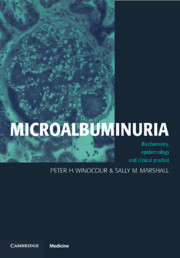Book contents
- Frontmatter
- Contents
- Preface
- Foreword by Professor K. G. M. M. Alberti
- 1 Renal structure and physiology
- 2 Measurement and expression of microalbuminuria
- 3 Epidemiology and determinants of microalbuminuria in health
- 4 Microalbuminuria in diabetes mellitus
- 5 Microalbuminuria as a marker of endothelial dysfunction
- 6 Microalbuminuria, cardiovascular risk factors and cardiovascular disease
- 7 Microalbuminuria as a non-specific marker of disease
- 8 The management of microalbuminuria in diabetes mellitus and essential hypertension
- Index
2 - Measurement and expression of microalbuminuria
Published online by Cambridge University Press: 06 July 2010
- Frontmatter
- Contents
- Preface
- Foreword by Professor K. G. M. M. Alberti
- 1 Renal structure and physiology
- 2 Measurement and expression of microalbuminuria
- 3 Epidemiology and determinants of microalbuminuria in health
- 4 Microalbuminuria in diabetes mellitus
- 5 Microalbuminuria as a marker of endothelial dysfunction
- 6 Microalbuminuria, cardiovascular risk factors and cardiovascular disease
- 7 Microalbuminuria as a non-specific marker of disease
- 8 The management of microalbuminuria in diabetes mellitus and essential hypertension
- Index
Summary
Introduction
Until the 1960s, quantitative methods of measuring low concentrations of albumin were laborious as they depended on the separation of protein by electrophoresis after concentration of the urine. In 1963, Keen and Chlouverakis described an immunoassay which was specific for albumin, required only small volumes of urine, was accurate and sensitive and was capable of dealing with large numbers of samples. This trail-blazing paper was not only the forerunner of many methodological developments, but also the starting point of much exciting research which has eventually established the significance of small amounts of albumin in the urine. Such increases in albuminuria which are undetectable by conventional dip-stick testing but greater than the normal excretion have been called microalbuminuria.
Laboratory measurement of microalbuminuria
General considerations
As discussed above, the assay must be specific for albumin, and hence have an immunological basis. It must be precise, sensitive and practicable. Currently the techniques commonly used are radioimmunoassay (RIA), single radial immunodiffusion (RID), immunoturbidimetry (IT), laser immunonephelometry (IN), and enzyme-linked immunosorbent assays (ELISA) (Table 2.1). There are many variations of each method and little has been published on comparisons of different techniques.
- Type
- Chapter
- Information
- MicroalbuminuriaBiochemistry, Epidemiology and Clinical Practice, pp. 11 - 39Publisher: Cambridge University PressPrint publication year: 1998
- 1
- Cited by



